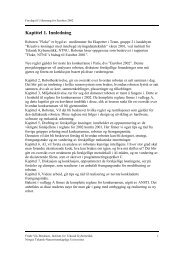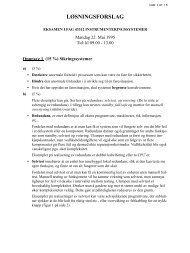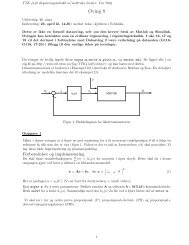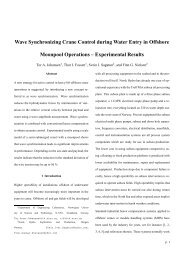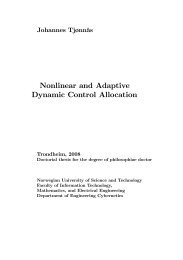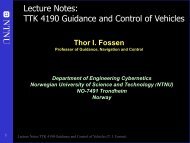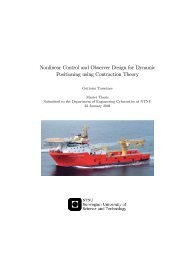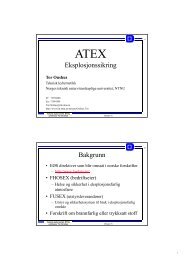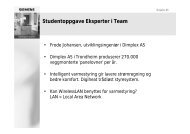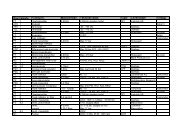Sliding-Mode Observer with Resistances or Speed Adaptation for ...
Sliding-Mode Observer with Resistances or Speed Adaptation for ...
Sliding-Mode Observer with Resistances or Speed Adaptation for ...
Create successful ePaper yourself
Turn your PDF publications into a flip-book with our unique Google optimized e-Paper software.
<strong>Sliding</strong>-<strong>Mode</strong> <strong>Observer</strong> <strong>with</strong> <strong>Resistances</strong> <strong>or</strong> <strong>Speed</strong> <strong>Adaptation</strong><br />
f<strong>or</strong> Field-Oriented Induction Mot<strong>or</strong> Drives<br />
Ciro Picardi<br />
Francesco Scibilia<br />
Dept. of Electronics, Computer and System Science<br />
University of Calabria<br />
Dept. of Electronics, Computer and System Science<br />
University of Calabria<br />
Via P. Bucci, 42C<br />
Via P. Bucci, 42C<br />
87036 Rende (CS), ITALY 87036 Rende (CS), ITALY<br />
picardi@deis.unical.it<br />
francesco.scibilia@gmail.com<br />
Abstract – A sliding-mode observer w<strong>or</strong>king in parallel <strong>with</strong> a<br />
particular adaptive scheme is proposed f<strong>or</strong> field-<strong>or</strong>iented<br />
control of induction mot<strong>or</strong>. The observer detects the rot<strong>or</strong> flux<br />
components in the two-phase stationary reference frame. The<br />
adaptive scheme is able to on-line estimate either the mot<strong>or</strong><br />
resistive parameters <strong>or</strong> the rot<strong>or</strong> speed. In the f<strong>or</strong>mer case, the<br />
adaptive scheme allows to have continuously the exact values of<br />
the stat<strong>or</strong> and rot<strong>or</strong> resistances, parameters usually subjected to<br />
variations from their nominal values. In the second one, the<br />
scheme can be used to realize an induction mot<strong>or</strong> sens<strong>or</strong>less<br />
speed control. The analytical development of the sliding mode<br />
observer and the adaptive scheme is fully explained. Simulation<br />
results, based on a Matlab/Simulink/Real-Time-W<strong>or</strong>kshop<br />
model designed on purpose, are presented to verify the validity<br />
of the proposed adaptive observer structure.<br />
I. INTRODUCTION<br />
The induction mot<strong>or</strong> has found very wide industrial<br />
applications due to its well-known advantages as simple<br />
construction, reliability and low cost. The most popular high<br />
perf<strong>or</strong>mance induction mot<strong>or</strong> control method is that one<br />
known as Field-Oriented Control. It is based on a d-q<br />
reference frame rotating synchronously <strong>with</strong> the rot<strong>or</strong> flux<br />
vect<strong>or</strong>, which allows to achieve a decoupled control between<br />
the flux and the produced t<strong>or</strong>que, likewise to a separately<br />
excited DC mot<strong>or</strong> [1].<br />
In Direct Field-Oriented Control, both the instantaneous<br />
magnitude and position of the rot<strong>or</strong> flux vect<strong>or</strong> are supposed<br />
to be precisely known. However, as the rot<strong>or</strong> flux cannot be<br />
directly measured, eff<strong>or</strong>ts have been made to estimate the<br />
rot<strong>or</strong> flux using various kinds of observers, based on the<br />
measurements of the stat<strong>or</strong> currents, the stat<strong>or</strong> voltages and<br />
the mot<strong>or</strong> speed.<br />
An imp<strong>or</strong>tant problem is that the exact values of the mot<strong>or</strong><br />
parameters, from which the observer and some high<br />
perf<strong>or</strong>mance control systems depend, are different from<br />
nominal values and change <strong>with</strong> respect to the temperature<br />
and the operating conditions. Another question is the need of<br />
a speed sens<strong>or</strong> to provide the rot<strong>or</strong> speed measurement,<br />
necessary to regulation purpose as well as observer<br />
operation. The presence of this sens<strong>or</strong> increases the drive<br />
cost and can reduce the robustness of the overall system;<br />
m<strong>or</strong>eover, in some cases a speed sens<strong>or</strong> cannot be mounted,<br />
such as mot<strong>or</strong> drives in a hostile environment and very highspeed<br />
mot<strong>or</strong> drives.<br />
The extended Kalman filters f<strong>or</strong> simultaneous estimation<br />
of the rot<strong>or</strong> flux, the speed and some mot<strong>or</strong> parameters<br />
(frequently only the rot<strong>or</strong> resistance, the parameter subjected<br />
to the widest variation) have been proposed as a potential<br />
solution to the above problems [2], [3]. Unf<strong>or</strong>tunately, this<br />
approach has some inherent disadvantages, such as the<br />
influence of noise and computation burden.<br />
In the last years, the sliding-mode observer has<br />
represented an attractive choice f<strong>or</strong> its being quite robust to<br />
disturbances, parameter deviations and system noise [4], [5].<br />
Adaptive flux sliding-mode observers, in which the mot<strong>or</strong><br />
speed is estimated by additional equations, have been<br />
designed trying to reduce the influence of parameters<br />
variations [6], [7], [8].<br />
This paper presents a sliding-mode observer w<strong>or</strong>king in<br />
parallel <strong>with</strong> a particular adaptive scheme. This scheme is<br />
able to on-line estimate either the mot<strong>or</strong> resistive parameters<br />
<strong>or</strong> the rot<strong>or</strong> speed. Thus, the adaptive sliding-mode observer<br />
allow to obtain a robust rot<strong>or</strong> flux estimation. M<strong>or</strong>eover, the<br />
configuration <strong>with</strong> the adaptive scheme f<strong>or</strong> the on-line<br />
estimation of stat<strong>or</strong> and rot<strong>or</strong> resistances values allows to<br />
implement high accurate speed controls, where there is the<br />
need to have constantly the right values of these parameters<br />
to preserve high level perf<strong>or</strong>mances. On the other hand, the<br />
configuration <strong>with</strong> the rot<strong>or</strong> speed estimation can be used f<strong>or</strong><br />
the implementation of a sens<strong>or</strong>less control.<br />
The paper explains the analytical development of the<br />
sliding-mode observer and the adaptive scheme.<br />
Finally, the validity of the proposed alg<strong>or</strong>ithms is verified<br />
by means of some simulation results, obtained using a<br />
Simulink model designed on purpose.<br />
II. FLUX OBSERVER-BASED FIELD-ORIENTED<br />
INDUCTION MOTOR DRIVES<br />
A. Induction Machine <strong>Mode</strong>l<br />
The induction mot<strong>or</strong> model, <strong>with</strong> the stat<strong>or</strong> currents and<br />
rot<strong>or</strong> fluxes defined as state variables, in the stationary α, β<br />
co<strong>or</strong>dinate system can be written as:<br />
⎡ p is<br />
⎤ ⎡ A11<br />
⎢ ⎥ = ⎢<br />
⎣ p φr<br />
⎦ ⎣ A21<br />
where p=d/dt<br />
R s + Rrp<br />
A11<br />
= − I<br />
σLs<br />
A12<br />
⎤ ⎡is<br />
⎤ ⎡B1<br />
⎤<br />
vs<br />
A<br />
⎥ ⎢ ⎥ + ⎢<br />
22 φr<br />
0<br />
⎥<br />
⎦ ⎣ ⎦ ⎣ ⎦<br />
A<br />
12<br />
1 ⎛ Rrp<br />
⎞<br />
= ⎜ I − ω J ⎟<br />
σL<br />
s ⎝ M ⎠<br />
A21 = Rrp<br />
I A − R rp<br />
22 = I + ω J<br />
M<br />
(1)
s =<br />
[ i i ] T<br />
i stat<strong>or</strong> current<br />
r<br />
sα<br />
LM<br />
Lr<br />
s β<br />
ϕ = φ , φ = [ φ φ ] T rot<strong>or</strong> flux<br />
s =<br />
r<br />
[ v v ] T<br />
sα<br />
s β<br />
r<br />
rα<br />
r β<br />
v stat<strong>or</strong> voltage<br />
R<br />
rp<br />
= R<br />
r<br />
⎛ L<br />
⎜<br />
⎝ L<br />
M<br />
r<br />
⎞<br />
⎟<br />
⎠<br />
2<br />
2<br />
M<br />
L<br />
M =<br />
L<br />
r<br />
σ = 1 −<br />
L 2<br />
M<br />
⎡1<br />
0⎤<br />
⎡0<br />
− 1⎤<br />
1<br />
I = ⎢ ⎥ J =<br />
⎣0<br />
1<br />
⎢ ⎥ B1<br />
= I<br />
⎦ ⎣1<br />
0 ⎦ σL s<br />
ω is the rot<strong>or</strong> electrical speed, subscripts α and β are used<br />
f<strong>or</strong> α-axis and β-axis components. L M<br />
, L r<br />
, R r<br />
, L s<br />
and R s<br />
are<br />
mutual inductance, rot<strong>or</strong> inductance and resistance, and stat<strong>or</strong><br />
inductance and resistance, respectively.<br />
B. Direct Field-Oriented Induction Mot<strong>or</strong> Drive System<br />
Fig. 1 shows the block diagram of a direct field-<strong>or</strong>iented<br />
induction mot<strong>or</strong> drive.<br />
The three desired stat<strong>or</strong> currents f<strong>or</strong> the current-controlled<br />
voltage-source-inverter (CR-VSI) are calculated by the<br />
following transf<strong>or</strong>mation equations from the two-phase d-q<br />
rotating reference frame to the three-phase stationary a-b-c<br />
system:<br />
isad = − isqd<br />
sin θˆ + isdd<br />
cosθˆ<br />
1<br />
( isqd<br />
+ 3 isdd<br />
) − cosθˆ ( isdd<br />
− isqd<br />
)<br />
2<br />
1<br />
( i − 3 i ) − cosθˆ ( i 3 i )<br />
1<br />
isbd<br />
sinθˆ<br />
3<br />
2<br />
1<br />
i scd = sinθˆ<br />
sqd sdd<br />
sdd + sqd<br />
2<br />
2<br />
= (2)<br />
where i sqd is the t<strong>or</strong>que current component, i sdd is the field<br />
current component and θˆ is the instantaneous angle between<br />
d-axis and a-axis.<br />
Since d-axis has to be aligned <strong>with</strong> the rot<strong>or</strong> flux space<br />
vect<strong>or</strong> and α-axis of the α−β stationary reference frame is<br />
aligned <strong>with</strong> a-axis, θˆ can be obtained as follows:<br />
cos θˆ<br />
where<br />
ˆ<br />
/ ˆ<br />
= φrα<br />
φr<br />
φr<br />
β φr<br />
φ r α<br />
sinθˆ<br />
= ˆ / ˆ<br />
(3)<br />
ˆ and ˆ φ r β are the components of the estimate<br />
2<br />
vect<strong>or</strong> ˆφ r of the rot<strong>or</strong> flux and ˆ 2<br />
φ ˆ ˆ<br />
r = φ rα + φrβ<br />
.<br />
Taking into account the induction mot<strong>or</strong> model used in (1),<br />
the vect<strong>or</strong> ˆφ r can be obtained as:<br />
ˆ φ = ˆ (L /L )<br />
(4)<br />
r ϕ r<br />
r<br />
M<br />
Keeping in mind (4), in the following, the vect<strong>or</strong><br />
used referring as the rot<strong>or</strong> flux vect<strong>or</strong>.<br />
L<br />
r<br />
L<br />
s<br />
ˆϕ r will be<br />
Fig. 1 Block diagram of direct field-<strong>or</strong>iented induction mot<strong>or</strong> drive.<br />
III. CURRENT AND FLUX SLIDING-MODE<br />
OBSERVERS DESIGN<br />
Assuming that the speed is measured and the parameters<br />
are exactly known, the sliding-mode observer can be seen as<br />
composed by two parts w<strong>or</strong>king in parallel: a current slidingmode<br />
observer and a rot<strong>or</strong> flux sliding-mode observer.<br />
The current sliding-mode observer is defined by the<br />
following equation and it uses the measured stat<strong>or</strong> voltage<br />
and current vect<strong>or</strong>s as inputs:<br />
pˆi s = A11is<br />
+ A12<br />
ˆ ϕ r + B1v<br />
s + K sgn( ei<br />
)<br />
(5)<br />
where ˆι s is the estimation of i s ,<br />
e ˆ<br />
i is<br />
− is<br />
surface, and<br />
⎡k1<br />
0 ⎤<br />
K = ⎢ ⎥ is the current gain matrix<br />
⎣ 0 k2<br />
⎦<br />
ˆϕ r is the estimation of ϕ r ,<br />
= is the stat<strong>or</strong> current err<strong>or</strong>, chosen as sliding-mode<br />
The rot<strong>or</strong> flux sliding-mode observer, using the measured<br />
stat<strong>or</strong> current vect<strong>or</strong> as input, is defined by the equation:<br />
p ˆ ϕr<br />
= A 21 is<br />
+ A22<br />
ˆ ϕr<br />
+ Η sgn( ei<br />
)<br />
(6)<br />
⎡h11<br />
h12<br />
⎤<br />
where Η = ⎢ ⎥ is the rot<strong>or</strong> flux gain matrix<br />
⎣h21<br />
h22<br />
⎦<br />
Defining the rot<strong>or</strong> flux err<strong>or</strong> as e ϕ = ˆ ϕr<br />
−ϕr<br />
, we obtain<br />
the following simple err<strong>or</strong> equations:<br />
p e i = A12 eϕ<br />
+ K sgn( ei<br />
)<br />
(7)<br />
p eϕ = A22 eϕ<br />
+ Η sgn( ei<br />
)<br />
(8)<br />
The design of the current gain matrix K can be derived by<br />
using the Lyapunov’s stability the<strong>or</strong>em. We choose the<br />
candidate Lyapunov function as follows:<br />
V1 = ( e T<br />
i e i ) / 2<br />
(9)<br />
This function is positive definite, satisfying the first<br />
Lyapunov stability condition. Taking into account (7), we<br />
can write the time derivative of V 1<br />
as follows:
T<br />
T<br />
pV1 = e i (p ei<br />
) = ei<br />
[ f + K sgn( ei<br />
)]<br />
(10)<br />
<strong>with</strong> f = [ f 1 f ]<br />
T<br />
2 = A12eϕ<br />
From the condition of (10) being definite negative, we<br />
obtain the following conditions f<strong>or</strong> the gain matrix K:<br />
k < , k 0 and k 1 > f1<br />
, k2<br />
> f 2<br />
(11)<br />
1 0 2 <<br />
Acc<strong>or</strong>ding to the equivalent control method, in sliding<br />
mode the system constituted by the two observers behaves as<br />
if the term sgn( e i ) is replaced by its equivalent value<br />
x = sgn( e )]<br />
, calculated by (7) assuming e p e = 0 :<br />
[ i<br />
eq<br />
i = i<br />
−1<br />
x = −K<br />
A12e ϕ<br />
(12)<br />
Substituting (12) into (8) and taking into account that<br />
A = − σL , we obtain:<br />
22 s A 12<br />
p eϕ = −Qe ϕ <strong>with</strong> Q [ I HK<br />
−1 = σ Ls<br />
+ ] A 12 (13)<br />
Then, we can make e ϕ → 0 by choosing<br />
Q = q I <strong>with</strong> q > 0<br />
(14)<br />
that leads to the following relation to determine H :<br />
−1<br />
H = [ QA12 − σLs<br />
I]<br />
K<br />
IV. CURRENT AND FLUX SLIDING-MODE<br />
OBSERVERS WITH ADAPTIVE SCHEME<br />
(15)<br />
In <strong>or</strong>der to take into account the parameter variations and<br />
the absence of the speed sens<strong>or</strong>, the auth<strong>or</strong>s proposes an<br />
adaptive scheme w<strong>or</strong>king in parallel <strong>with</strong> the sliding-mode<br />
observers described in the previous section (Fig. 2).<br />
The equations of the two observers become:<br />
pi ˆ ˆ ˆ<br />
s = A11is<br />
+ A12<br />
ˆ ϕ r + B1v<br />
s + K sgn( ei<br />
)<br />
(16)<br />
p ˆ ϕ ˆ ˆ<br />
r = A 21 is<br />
+ A22<br />
ˆ ϕ r + Η sgn( ei<br />
)<br />
(17)<br />
where ˆι s , ˆϕ r , e i , K , H are already defined and<br />
A ˆ ij = Αij<br />
+ ∆Aij<br />
(i, j = 1,2) <strong>with</strong> ∆ A ij denoting the estimation<br />
of the parameter and speed variations from their real values.<br />
In particular, we consider that this adaptive scheme is able to<br />
operate in two different ways. In the f<strong>or</strong>mer, it gives the<br />
estimated values of the resistive parameters Rˆ s and Rˆ rp ;<br />
then, it can be seen as on-line identification scheme allowing<br />
the realization of high perf<strong>or</strong>mance drive systems, f<strong>or</strong> which<br />
the actual values of stat<strong>or</strong> and rot<strong>or</strong> resistances are required.<br />
In the latter way, the adaptive scheme provides the<br />
estimation ωˆ of the rot<strong>or</strong> speed and allows the realization of<br />
a sens<strong>or</strong>less speed control.<br />
Fig. 2 Configuration of current and flux sliding-mode observers<br />
w<strong>or</strong>king in parallel <strong>with</strong> the adaptive scheme<br />
Theref<strong>or</strong>e, in the case considered in this paper, the matrices<br />
are specified as:<br />
Âij<br />
Rˆ<br />
s + Rˆ<br />
⎛<br />
⎞<br />
rp<br />
Aˆ<br />
11 = − I<br />
⎜<br />
Rˆ<br />
Aˆ<br />
1 rp ⎟<br />
12 = I − ωˆ J<br />
σL<br />
⎜<br />
⎟<br />
s<br />
σLs<br />
M<br />
⎝<br />
⎠<br />
A ˆ Rˆ<br />
21 = Rˆ<br />
rp I<br />
Aˆ<br />
rp<br />
22 = − I + ωˆ J (18)<br />
M<br />
where Rˆ<br />
s = Rs<br />
+ ∆ Rs<br />
, Rˆ<br />
rp = Rrp<br />
+ ∆ Rrp<br />
and ˆ ω = ω + ∆ω<br />
.<br />
A. Adaptive Scheme f<strong>or</strong> Resistive Parameters Identification<br />
If a rot<strong>or</strong> speed measure is available ( ∆ ω = 0 ), from (1),<br />
(16) and (18) we obtain the following current err<strong>or</strong> equation:<br />
pe i = ∆ A11is<br />
+ A12eϕ<br />
+ ∆A12<br />
ˆ ϕr<br />
+ K sgn( ei<br />
) (19)<br />
where<br />
∆ Rs<br />
+ ∆ Rrp<br />
1 ⎛ ∆ Rrp<br />
⎞<br />
∆A11<br />
= −<br />
I ∆A<br />
12 = ⎜ I − ω J ⎟<br />
σL<br />
s<br />
σLs<br />
⎝ M ⎠<br />
The adaptive scheme can be derived by using the<br />
Lyapunov’s stability the<strong>or</strong>em. We choose the following<br />
positive definite Lyapunov function:<br />
T<br />
V2 = ( i ei<br />
) / 2<br />
2<br />
Rs<br />
/ 2ks<br />
2<br />
Rrp<br />
/ 2krp<br />
e + ∆ + ∆<br />
(20)<br />
where k s<br />
and k rp<br />
are positive constants.<br />
The time derivative of V 2<br />
becomes:<br />
T<br />
pV2 = ei<br />
(p ei<br />
) + ∆ Rs(p Rˆ<br />
s /ks<br />
) + ∆ Rrp(pRˆ<br />
rp /krp<br />
) (21)<br />
Taking into account (19), we obtain<br />
⎡ Rˆ<br />
s 1 T<br />
⎤<br />
pV2<br />
= pV1<br />
+ ∆ Rs<br />
⎢ p − ei<br />
is<br />
⎥ +<br />
⎢⎣<br />
ks<br />
σLs<br />
⎥⎦<br />
(22)<br />
⎡ Rˆ<br />
rp 1 ˆ ⎤<br />
T ϕ<br />
+ R ⎢<br />
r<br />
∆ rp p − ei<br />
( is<br />
− ) ⎥<br />
⎢ k σL M<br />
⎣ rp s<br />
⎥⎦<br />
where the function pV 1 is given by (10).<br />
Let the second term null and the third term null in (22), we<br />
can find the following adaptive scheme f<strong>or</strong> the resistive
parameters identification:<br />
Rˆ<br />
−1<br />
ks<br />
T<br />
= p ( ei<br />
is<br />
)<br />
(23)<br />
σL<br />
s<br />
s<br />
1 krp<br />
T ˆ ϕr<br />
Rˆ<br />
rp = p<br />
− [ i ( is<br />
− )]<br />
σLs<br />
M<br />
e (24)<br />
By means of (23) and (24) the time derivative pV 2 is equal<br />
to pV 1 and thus it is negative definite choosing the conditions<br />
given in (11). In other w<strong>or</strong>ds, the matrix K f<strong>or</strong> the adaptive<br />
current sliding-mode observer defined by (16) can be<br />
designed on the basis of conditions (11).<br />
Under the assumption that the sliding mode is attained and<br />
the resistive parameters identification is completed, the<br />
design strategy of the rot<strong>or</strong> flux gain matrix H is the same<br />
described in the previous section, that led to relation (15).<br />
B. Adaptive Scheme f<strong>or</strong> Rot<strong>or</strong> <strong>Speed</strong> Estimation<br />
In <strong>or</strong>der to derive an adaptive scheme f<strong>or</strong> rot<strong>or</strong> speed<br />
estimation we define the following definite positive<br />
Lyapunov function:<br />
T 2<br />
W = ( e ϕ eϕ<br />
) / 2 + ∆ω<br />
/ 2kω<br />
(25)<br />
where k ω is a positive constant.<br />
The time derivative of W is expressed as<br />
T<br />
pW = e ϕ (p eϕ<br />
) + ∆ω(p<br />
ˆ ω /kω<br />
)<br />
(26)<br />
By considering only the rot<strong>or</strong> speed as variable, we obtain:<br />
∆ A11 = ∆A21<br />
= 0, ∆A22<br />
= − σLs<br />
and ∆A12<br />
= ∆ωJ.<br />
So, the<br />
current and flux err<strong>or</strong> equations can be written as:<br />
pe i = A12 eϕ<br />
−(<br />
∆ω /σ Ls<br />
) J ˆ ϕr<br />
+ K sgn( ei<br />
) (27)<br />
pe ϕ = − σLs<br />
A12 eϕ<br />
+ ∆ωJ<br />
ˆ ϕr<br />
+ H sgn( ei<br />
)<br />
(28)<br />
In acc<strong>or</strong>ding <strong>with</strong> the equivalent control method, if the<br />
current traject<strong>or</strong>ies reach the sliding manifold, i.e. p e i = 0 ,<br />
from (27) and (28) we obtain:<br />
definite and the following equation f<strong>or</strong> the speed estimation<br />
is obtained:<br />
1 qk<br />
ˆ − ω T T<br />
ω = p [ x K J ˆ ϕr<br />
]<br />
(32)<br />
dσ L<br />
s<br />
V. SIMULATION RESULTS<br />
In this section, the perf<strong>or</strong>mance of the proposed observer is<br />
presented via simulation results. Fig. 3 shows the Simulink<br />
block diagram designed to simulate the drive system.<br />
As shown in Fig. 1, the field-<strong>or</strong>iented controller is based on<br />
a CR-VSI structure: the output of the speed regulat<strong>or</strong><br />
represents the q-axis desired current i sqd<br />
, while the field<br />
weakening block gives the d-axis desired current i sdd;<br />
a (d,q)<br />
to (a,b,c) transf<strong>or</strong>mation provides the components i sad<br />
, i sbd<br />
and<br />
i scd<br />
necessary f<strong>or</strong> the current regulat<strong>or</strong>s. These are fixed<br />
frequency hysteresis regulat<strong>or</strong>s and give the inputs to the<br />
VSI. Standard prop<strong>or</strong>tional plus integral controllers (<strong>with</strong><br />
anti-windup system) are used f<strong>or</strong> speed and flux regulat<strong>or</strong>s.<br />
The adaptive sliding-mode observer provides the rot<strong>or</strong> flux<br />
position θˆ , necessary f<strong>or</strong> the field <strong>or</strong>ientation, and the flux<br />
magnitude ˆφ r , used also to close the flux control loop as<br />
described in relations (2) and (3).<br />
The adaptive scheme can operate either as resistive<br />
parameter identification <strong>or</strong> as rot<strong>or</strong> speed estimation.<br />
The whole control system is discretized <strong>with</strong> a 10 µ s time<br />
step. In <strong>or</strong>der to simulate a microcontroller device<br />
environment the “Adaptive SM <strong>Observer</strong>” uses a 20 µ s<br />
sample time, the “<strong>Speed</strong> Controller” uses a 60 µ s sample<br />
time and the “F.O.C” uses a 20 µ s sample time.<br />
To further on investigate the implementation feasibility,<br />
two standalone real-time applications f<strong>or</strong> a 32-bit Generic<br />
Embedded Process<strong>or</strong> has been developed from the Simulink<br />
drive system model using Real-Time-W<strong>or</strong>kshop (RTW).<br />
The mot<strong>or</strong> parameter nominal values are the following:<br />
PW = 370 W P = 2 poles<br />
V = 230 Volts I s = 1. 7 Amps<br />
s<br />
R s = 24.6 Ohm R = 16. 1Ohm<br />
L = 39.8 mH L = 26. 1mH L = 1. 46 mH<br />
s<br />
r<br />
r<br />
M<br />
1<br />
eϕ = A12 − [( ∆ω /σ Ls<br />
) J ˆ ϕr<br />
− Kx]<br />
(29)<br />
−1<br />
pe<br />
ϕ = [ σLs<br />
K + H]<br />
x = QA12<br />
Kx<br />
(30)<br />
where x = sgn( e )]<br />
and Q is the matrix given in (14).<br />
[ i<br />
−1<br />
T<br />
12 ]<br />
eq<br />
Since [ A = A /d<br />
12<br />
<strong>with</strong> d = det [ A 12 ] > 0 and<br />
Q = q I <strong>with</strong> q > 0 , the time derivative of W becomes:<br />
q T T<br />
q T T pωˆ<br />
pW = − x K Kx + ∆ ω[<br />
− x K J ˆ ϕr<br />
+ ] (31)<br />
d<br />
dσ L<br />
k<br />
s<br />
ω<br />
The first term in (31) is negative definite; thus, imposing the<br />
second term null, the whole function pW is negative<br />
Fig. 3 High level block diagram of the drive system considered
A. <strong>Sliding</strong>- <strong>Mode</strong> <strong>Observer</strong> <strong>with</strong>out Adaptive Scheme<br />
The sliding mode observer is used to calculate the rot<strong>or</strong><br />
flux components in <strong>or</strong>der to implement the field <strong>or</strong>iented<br />
control. The mot<strong>or</strong> operates under nominal t<strong>or</strong>que load and it<br />
is driven to a desired rot<strong>or</strong> speed of 200 rpm.<br />
Fig. 4 shows the real and the estimated values of a<br />
component of rot<strong>or</strong> flux when the parameters are assumed<br />
exactly known. Fig. 5 shows the real and the estimated<br />
values of the same component of rot<strong>or</strong> flux, when we<br />
suppose the stat<strong>or</strong> and the rot<strong>or</strong> resistances are affected by<br />
+5% and +10% variations f<strong>or</strong>m their nominal values<br />
respectively. It can be seen that the estimated flux is accurate<br />
and robust <strong>with</strong> respect to the resistive parameters variations.<br />
Fig. 6 Stat<strong>or</strong> resistance identification, <strong>with</strong> 5% variation<br />
from nominal value<br />
Fig. 4 Real and estimated<br />
φ r α<br />
Fig. 7 Rot<strong>or</strong> resistance identification <strong>with</strong> 10% variation<br />
from nominal value<br />
Fig. 5 Real and estimated<br />
φ r α under parameters variation<br />
Fig. 8 Identification of a unknown stat<strong>or</strong> resistance<br />
B. <strong>Sliding</strong> <strong>Mode</strong> <strong>Observer</strong> <strong>with</strong> Adaptive Scheme<br />
f<strong>or</strong> Resistive Parameters Identification<br />
The adaptive scheme, w<strong>or</strong>king in parallel <strong>with</strong> the sliding<br />
mode observer, allows to obtain the c<strong>or</strong>rect value of resistive<br />
parameters, which can change from the nominal ones<br />
acc<strong>or</strong>ding to mot<strong>or</strong> temperature and operating condition.<br />
Fig. 6 and 7 show the results of the identification adaptive<br />
scheme when a step parameter variation of the two resistive<br />
parameters is considered. Fig. 8 and 9 show how the<br />
proposed adaptive scheme is able to estimate the c<strong>or</strong>rect<br />
values of the stat<strong>or</strong> and rot<strong>or</strong> resistances also when they are<br />
supposed completely unknown.<br />
Fig. 9 Identification of a unknown rot<strong>or</strong> resistance
C. <strong>Sliding</strong> <strong>Mode</strong> <strong>Observer</strong> <strong>with</strong> Adaptive Scheme<br />
f<strong>or</strong> Rot<strong>or</strong> <strong>Speed</strong> Estimation<br />
This adaptive scheme allows to eliminate the speed sens<strong>or</strong><br />
using an estimation of the rot<strong>or</strong> speed in place of the<br />
measured one.<br />
Fig. 10 and 11 show the transient behaviour of the system<br />
in two particular operating conditions: speed reversion and<br />
mot<strong>or</strong> braking, when the mot<strong>or</strong> is under nominal load t<strong>or</strong>que.<br />
Finally, Fig. 12 refers to a real-time simulation done using<br />
the standalone application developed from the Simulink<br />
model of this scheme.<br />
VI. CONCLUSION<br />
In this paper a particular adaptive scheme w<strong>or</strong>king in<br />
parallel <strong>with</strong> a sliding-mode observer has been developed.<br />
The Lyapunov’s stability the<strong>or</strong>em has been used in the<br />
development, granting the stability of the adaptive slidingmode<br />
observer.<br />
This adaptive scheme cannot estimate simultaneously the<br />
resistive parameters and the speed, because the estimation is<br />
done using only the stat<strong>or</strong> electrical quantities and so the<br />
err<strong>or</strong> signal suitable to be used as “engine” f<strong>or</strong> the estimation<br />
mechanism, is not enough. Thus, the proposed configuration<br />
can be used either when the speed is measured but the exact<br />
values of stat<strong>or</strong> and rot<strong>or</strong> resistances are required as in high<br />
perf<strong>or</strong>mance drives <strong>or</strong> to realize a sens<strong>or</strong>less control where<br />
the characteristics of robustness and parameter insensitivity<br />
of the sliding-mode approach are considered adequate.<br />
The paper has shown some simulation results, based on the<br />
development of a Matlab/Simulink/Real-Time-W<strong>or</strong>kshop<br />
model, which have proved the validity of the proposed<br />
scheme in different significant operating conditions.<br />
V. REFERENCES<br />
Fig. 10 Reference and estimated speeds<br />
Fig. 11 Reference and estimated speeds<br />
[l] P. Vas, Vect<strong>or</strong> Control of AC Machines, New-Y<strong>or</strong>k;<br />
Oxf<strong>or</strong>d University Press, 1990, p.120.<br />
[2] M. La Cava, C. Picardi and F. Ranieri, “Application of<br />
the extended Kalman filter to parameter and state<br />
sstimation of induction mot<strong>or</strong>s, ”, International Journal<br />
of <strong>Mode</strong>lling & Simulation, vol. 9, no.3, 1989, pp.85-89.<br />
[3] R. Kim, S. K. Sul, and M. H. Park, “<strong>Speed</strong> sens<strong>or</strong>less<br />
vect<strong>or</strong> control of induction mot<strong>or</strong> using extended<br />
Kalman filter,” IEEE Trans. Ind. Applic., vol. 30,<br />
Sept/Oct 1994, pp.1225-1233.<br />
[4] V. I. Utkin, “<strong>Sliding</strong> <strong>Mode</strong> Control Design Principles<br />
and Application to Electric Drives”, IEEE Trans. Ind.<br />
Electronics, vol. 40, no. 1, Feb. 1993, pp. 23-26<br />
[5] J. Y. Hung and W. Gao and J. C. Hung, “Variable<br />
Structure Control: A survey”, IEEE Trans. Ind.<br />
Electronics, vol. 40, no. 1, Feb. 1993, pp. 2-22.<br />
[6] H. Kubota and K. Matsuse, “<strong>Speed</strong> Sens<strong>or</strong>less Field-<br />
Oriented Control of Induction Mot<strong>or</strong> <strong>with</strong> Rot<strong>or</strong><br />
Resistance <strong>Adaptation</strong>”, IEEE Trans. Ind. Applic., vol.<br />
30, no. 5, Sept/Oct 1994, pp. 1219-1224.<br />
[7] M. Tursini, R. Petrella and F. Parasiliti, “Adaptive<br />
<strong>Sliding</strong>-<strong>Mode</strong> <strong>Observer</strong> f<strong>or</strong> Sens<strong>or</strong>less Control of<br />
Induction Mot<strong>or</strong>s”, IEEE Trans. Ind. Applic., vol. 36,<br />
no. 5, Sept/Oct 2000, pp. 1380-1387.<br />
[8] J. Li, L. Xu and Z. Zhang, “An Adaptive <strong>Sliding</strong> <strong>Mode</strong><br />
<strong>Observer</strong> f<strong>or</strong> Induction Mot<strong>or</strong> Sens<strong>or</strong>less <strong>Speed</strong><br />
Control”, Ind. Appl. Conf., 39 th<br />
Annual Meeting<br />
Conference, Oct. 2004, pp.1329-1334.<br />
Fig. 12 Reference and estimated speed in real-time simulation



